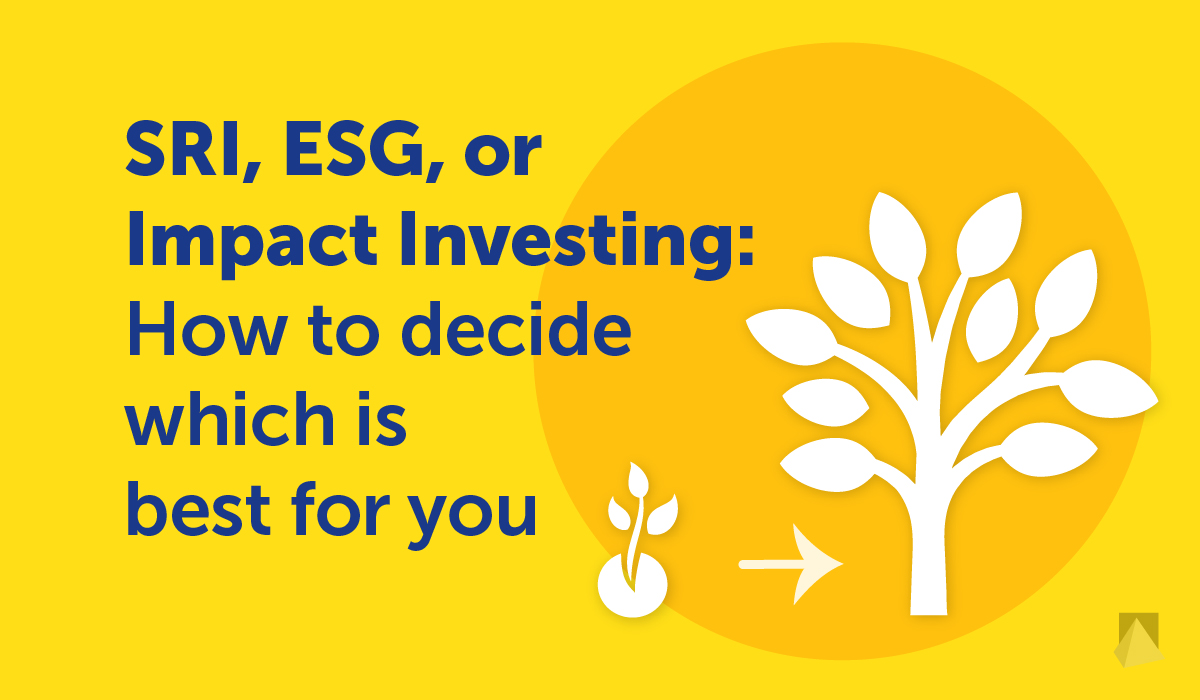3 min read
SRI, ESG, or Impact Investing: How to decide which is best for you
Adam Robert : October 8, 2020

By whatever its name, the options for putting your money where your personal values are have never been greater. But the array of terms can be overwhelming. Whether you are just beginning as an investor or have been investing for years, a recap of your choices can be useful to make sure you aren’t simply chasing after the latest shiny object — or missing out on a growing trend that’s a perfect match for your personal values and investing goals.
SRI vs. ESG vs. Impact Investing: What’s the difference?
There are three broad styles of investing that include consideration of your social values in addition to traditional financial criteria: Environmental, social and governance (ESG), socially responsible investing (SRI) and impact investing.
Environmental, social and governance (ESG) — Considers environmental, social and governance (ESG) practices as screens for an investment. The integration of ESG factors is used to enhance traditional financial analysis by identifying potential risks and opportunities beyond technical valuations. While there may be an overlay of social consciousness, the main objective of ESG valuation remains financial performance.
Socially Responsible Investing - Considers issues based on specific ethical guidelines such as environmental responsibility, human rights, or religious views. A socially conscious fund may take a pro-active stance by selectively investing in, for example, environmentally friendly companies, or firms with good employee relations. This approach also includes what are known as negative or exclusionary screens — funds that avoid investing in companies involved in social negatives such as promoting alcohol, tobacco, or gambling, or the defense industry.
Impact investing — In impact or thematic investing, positive outcomes are of the utmost importance — meaning the investments need to have a positive impact in some way. So, the objective of impact investing is to help a business or organization accomplish specific goals, projects, or business activities that are beneficial to society or the environment. Investing in businesses owned by women or people of color in lower-income areas is an example. Impact investments are investments made with the intention to generate positive, measurable social and environmental impact alongside some form of financial return.
Trends
Values-based investing is not an overnight sensation. According to US SIF: The Forum for Sustainable and Responsible Investment, socially responsible investing (SRI); environment, social and corporate governance (ESG) investing and impact investing assets grew from $3 trillion in 2010 to $12 trillion in 2018.
Though the definitions and assessments of financial returns may vary, three trends are clear:
- There is heightened interest by companies and investors in ESG factors (Google Trends)
- ESG-related investing assets are growing (Global Sustainable Investment Alliance)
- Global initiatives and regulatory developments are supporting continued growth in ESG, socially responsible, and impact investing (United Nations PRI Global Guide to Responsible Investment Regulation)
These trends were accelerated and reinforced by two announcements in September 2020:
- The European Commission, the executive branch of the European Commission, said it would fund one third of its coronavirus recovery fund spending with green debt, or the equivalent of $263 billion.
- The European Central Bank announce it will start buying sustainability-linked corporate bonds and accepting them as collateral for loans to commercials banks.
Four Steps to Make the Best ESG Investment Decision for You
If you want to move into or expand your ESG investments, here are four recommended steps to take. Ask yourself:
- Define your goals — Which is primary for you? Financial return, negative screens, or social impact on a topic or theme?
- Evaluate the options: ESG only, socially response, impact investing – or a mix?
- Decide on action: Shift your allocations or invest new funds to match your goals.
- Reassess periodically: Your priorities and investment options can change. Add periodic reassessments to your tickler for regular review.
Your financial advisor or a CERTIFIED FINANCIAL PLANNER™ or CFP® professional can be a valuable partner to help you think through your options and decide whether SRI, ESG, or Impact Investing is the best choice for you. Go forth with confidence!
Resources
US Sustainable, Responsible and Impact Investing Trends
Is Your Money Invested Where Your Values Are?
Core Characteristics of Impact Investing, GIIN
Financial Factors in Selecting (Retirement) Plan Investments, U.S. Dept. of Labor
The ESG Premium: New perspectives on performance (McKinsey)
Global Guide to Responsible Investment Regulation, United Nations PRI. (PDF)
Google Trends: esg investing graph
United Nations Principles for Responsible Investment (PRI), Investment Tools
------------
Adam W. Robert, CFP® of Clute Wealth Management in South Burlington, VT and Plattsburgh, NY, an independent firm that provides strategic financial and investment planning for individuals and small businesses in the Champlain Valley region of New York and Vermont. This information is not intended to be a substitute for specific individualized tax or legal advice. We suggest that you discuss your specific situation with a qualified tax or legal advisor.


